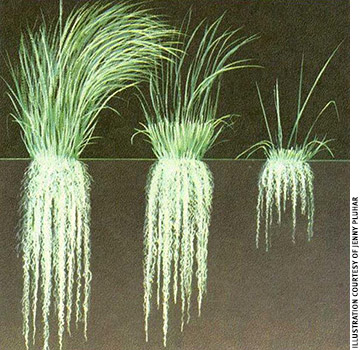After the Drought

When is it time to restock?
Much of the West has suffered several years of drought. This year some regions received more moisture and pastures greened up. Ranchers who sold cattle are thinking about rebuilding their herds.
Jenny Pluhar, a range scientist and consultant in Canyon, Texas, says in many areas it will take more than a few rains or even an “average” or “above average” year for grass to recover. In some regions, much of the dry grass is not dormant, but dead.
“Stocking rate is the single most important decision for a landowner, renter or land steward. Too many people make stocking decisions without carefully evaluating their resources. The plants may have turned green, but the grass is still not growing. It may have some seedheads but not much plant mass,” says Pluhar.
One rancher showed her part of his ranch where the buffalo grass, blue grama and other short-grass species were dead.
“I showed him an illustration of grass that had been lightly grazed, with lots of root mass, compared to grass that had been more severely grazed, with less root mass. The next picture shows grass that was grazed hard over the years, putting all its energy into trying to maintain life on the surface — with significantly less root mass — and died,” says Pluhar.
“We see a lot of dead grass in this part of the world, not so much from drought, but from historic heavy stocking. When severe drought hit us in 2011, it wasn’t the drought that killed the grass, but all the years of heavy grazing,” she notes. Native rangeland needs careful management.
“We need to evaluate grass before it goes dormant in fall, and make sure at least 25% of the plants have seedheads. You shouldn’t graze it all off; you need to leave something for the future,” Pluhar adds.
When she does ranch consulting, Pluhar builds cage enclosures to monitor grass, to see what it looks like where it’s grazed and where it’s not grazed. She says, “I build enclosures in key areas — but also where whoever is [managing] the cattle can readily see them.
“Ranchers can also set up photo points to compare grass today with what it looked like last spring, or this time last year, or two years ago, or 10. Take a picture at that spot at least twice a year, preferably four [times]. This helps you see what you’ve got — and whether it’s improving or not. When you see it every day, it’s hard to notice changes over time.”
She tells people who want to restock that they shouldn’t make that decision just because the pasture looks green now. “Walk through and evaluate it. Dig a few holes and see what the roots look like, and if there is any subsoil moisture.” Is the pasture green just from temporary surface moisture and/or annual weeds taking advantage of a little moisture to sprout and grow? Perennial grasses may be dead.
“The first step is to identify what’s growing, and see what you have for subsoil moisture, and realize it will take time to make up for severely dry year(s). In our area we’ve had some big rains that filled dirt tanks, but it happened quickly, with a lot of runoff, and didn’t soak into the ground enough to help the soil profile,” she explains.

Editor’s Note: Heather Smith Thomas is a freelancer and cattlewoman from Salmon, Idaho.





